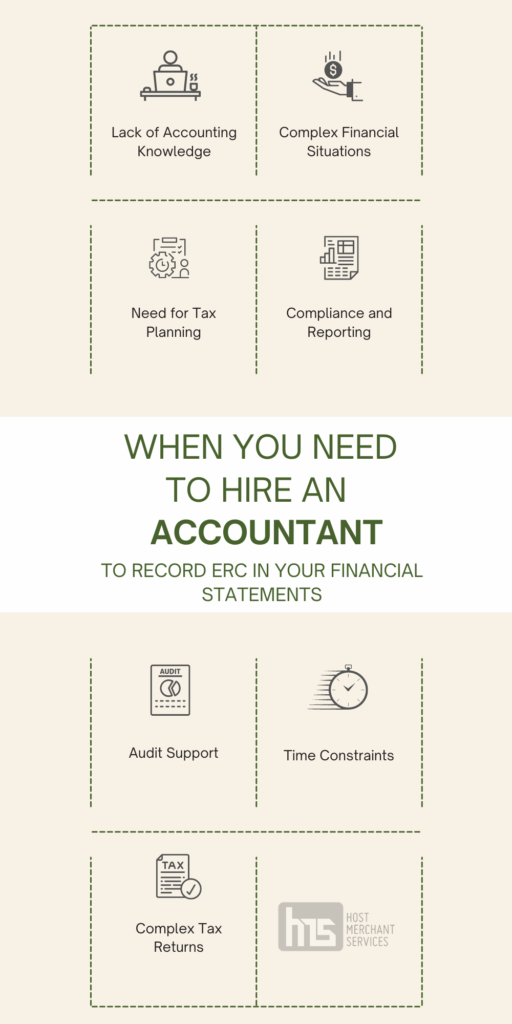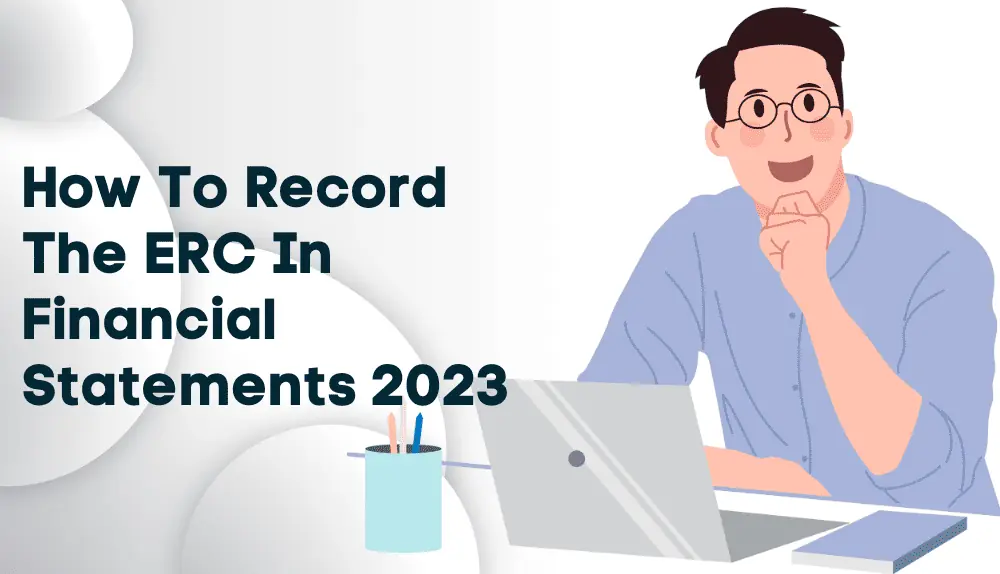Are you wondering how to write down the employee retention credit in your financial statements for the year 2023? Whether you already got the credit or need to fix your tax return to claim it later, recording it correctly is essential. But don’t worry; we’re here to help you with simple steps! In this easy-to-follow post, we’ll show you how to put the employee retention credit in your accounting software.
Just follow our instructions, and your financial statements will be all set with the right credit amount. Get ready to understand better how to record the employee retention credit for 2023 in your financial records!
What is ERC in Financial Statements?

The Employee Retention Credit (ERC) is a valuable tax incentive provided by the government to support businesses and encourage them to retain their employees during challenging times. It was introduced to combat the economic impact of the COVID-19 pandemic and help businesses stay afloat.
To put it simply, the ERC enables qualified businesses to claim a tax credit for a portion of the qualified wages they have paid to their workers. The credit’s size is significant and can immediately lower the employer’s tax obligation or even produce a refund.
Businesses must fulfill certain requirements, such as having a reduction in gross receipts or being subject to government orders that have a major impact on their operations, in order to be eligible for the ERC. The credit also covers earnings paid to both active workers and those on paid leave or furlough.
The ERC serves as a lifeline for businesses, providing financial relief and the means to retain their workforce during uncertain times. As the economic landscape continues to evolve, understanding and leveraging the ERC can make a significant difference for businesses striving to navigate the challenges ahead.
How to Record the Employee Retention Credit in Accounting Software

The Employee Retention Credit (ERC) is a valuable tax incentive designed to support businesses during challenging times, such as the COVID-19 pandemic. As a business owner, properly recording the ERC in your accounting software is essential to ensure accurate financial reporting. In this section, we’ll walk you through the step-by-step process to record the Employee Retention Credit in your accounting software.
STEP 1: Record Your Tax Payment in the General Ledger
Before recording the ERC, you need to ensure that any related tax liabilities are accurately recorded in your general ledger. This step is crucial to maintain precise financial records and calculate the correct ERC amount.
- Identify the Tax Payment: Determine the amount of payroll taxes you paid for the designated period, which includes Social Security, Medicare, and income taxes.
- Create a Journal Entry: Record the tax payment in your general ledger using a journal entry. Debit the appropriate tax expense accounts and credit your cash or bank account to reflect the payment made.
STEP 2: Create an Accounting Entry for an Anticipated ERC Refund
Once you’ve paid the eligible payroll taxes, you can anticipate an ERC refund. This accounting entry helps you track the expected refund until it is received.
- Set Up an ERC Refund Account: Create a separate account in your accounting software to track the anticipated ERC refund. Name it clearly, such as “Anticipated ERC Refund.”
- Record the Anticipated Refund: Create a journal entry to record the anticipated refund. Debit the Anticipated ERC Refund account and credit the appropriate income or receivable account to reflect the expected credit.
STEP 3: Create an Accounting Entry for Your ERC Refund
When you receive the actual ERC refund, you need to record it accurately in your accounting software. This step ensures that your books reflect the credit received and maintains the integrity of your financial statements.
- Receive the ERC Refund: Once you receive the ERC refund, deposit the funds into your bank account.
- Create a Journal Entry: Record the ERC refund in your general ledger using a journal entry. Debit your cash or bank account to reflect the credit received. Then, credit the Anticipated ERC Refund account to close it out.
Recording the Employee Retention Credit in your accounting software is crucial for accurate financial reporting and compliance. By following these steps and using the features available in your accounting software, you can efficiently and accurately record the ERC, maximizing its benefits for your business during challenging times. Always consult with a tax professional or accountant to ensure you adhere to all IRS guidelines and take full advantage of the ERC’s potential benefits. Properly recorded ERC transactions not only help you stay compliant but also provide valuable insights into your business’s financial health.
When You Need to Hire an Accountant to Record ERC in Your Financial Statements

Hiring an accountant to record the Employee Retention Credit (ERC) in your financial statements can be a wise decision, especially if you lack the expertise or time to navigate the complexities of tax regulations. Here are some scenarios where it might be beneficial to seek professional assistance:
Lack of Accounting Knowledge
If you don’t have a solid understanding of accounting principles and tax laws, recording the ERC accurately can be challenging. Hiring an accountant ensures the credit is correctly calculated and recorded, preventing any errors that could lead to financial complications later on.
Complex Financial Situations
Businesses with multiple employees, different wage rates, or varying hours worked may have a more intricate ERC calculation. An accountant can navigate these complexities effectively and ensure all eligible wages are considered.
Need for Tax Planning
An accountant can help you strategize and plan your ERC claim effectively to maximize the credit. They can advise on the best timing for claiming the credit to optimize its impact on your financials.
Compliance and Reporting
ERC regulations can be constantly changing, and it’s essential to stay compliant with the latest IRS guidelines. A skilled accountant can keep you up-to-date with any modifications and ensure accurate reporting on your financial statements.
Audit Support
In the event of an IRS audit, having an accountant who has recorded the ERC correctly can provide valuable support. They can help you gather the necessary documentation and represent you during the audit process.
Time Constraints
Running a business involves various responsibilities, and handling ERC calculations can be time-consuming. Outsourcing this task to an accountant allows you to focus on core business operations while ensuring the credit is recorded accurately.
Complex Tax Returns
If your business has complex tax returns, an accountant’s expertise can be invaluable. They can ensure that the ERC is integrated seamlessly into your tax filings, avoiding any potential issues with the IRS.
While recording the ERC in your financial statements can be done independently, hiring an accountant offers numerous benefits. From accurate calculations to compliance with changing regulations, an accountant brings specialized knowledge and expertise to optimize your ERC claim. It’s essential to weigh the complexities of your business and the potential benefits of professional assistance to make an informed decision about hiring an accountant for ERC-related tasks.
Is it Necessary to Record ERC in Your Financial Statements?
The Employee Retention Credit (ERC) is a valuable tax incentive designed to support businesses during challenging times, such as the COVID-19 pandemic. While claiming credit is optional, properly recording it in your financial statements is essential for several reasons. In this article, we’ll explore the importance of recording ERC in your financial statements and the benefits it offers.
Compliance with Accounting Standards
Accurate financial reporting is a fundamental requirement for any business. Recording the ERC in your financial statements ensures compliance with accounting standards and provides a clear and transparent view of your company’s financial health. Failure to record the credit correctly can lead to discrepancies in your financial statements, which may raise concerns during audits or financial reviews.
Enhanced Financial Transparency
Recording the ERC in your financial statements enhances financial transparency. It allows stakeholders, such as investors, creditors, and shareholders, to understand the impact of the credit on your business’s financial performance. Transparent financial reporting instills confidence in your company’s operations and financial management.
Improved Decision-Making
Accurate recording of the ERC provides valuable financial insights that aid in informed decision-making. Business owners and managers can assess the credit’s impact on cash flow, profitability, and overall financial position. This information is crucial for making strategic decisions about future investments, expansion plans, or operational adjustments.
Maximizing Tax Benefits
The ERC can significantly reduce your tax liability or even result in a tax refund. By properly recording the credit, you can maximize the tax benefits for your business. This extra cash flow can be reinvested into the company or used to fund growth initiatives.
IRS Compliance and Audit Preparedness
The IRS may conduct audits to ensure businesses are correctly claiming the ERC. By accurately recording the credit in your financial statements, you demonstrate compliance with IRS guidelines. Should your business face an audit, having proper documentation and records will provide a smoother audit process and reduce the risk of penalties or fines.
Demonstrating Financial Stability
During challenging economic times, such as a pandemic, businesses that demonstrate financial stability are more attractive to investors and lenders. Properly recorded ERC credits indicate that your business is actively utilizing available tax incentives to weather the economic challenges, thereby reinforcing its financial stability.
Recording the Employee Retention Credit in your financial statements is not just necessary; it is crucial for accurate financial reporting, compliance with accounting standards, and maximizing the tax benefits it offers. Properly recorded ERC credits enhance financial transparency, aid in decision-making, and demonstrate your business’s financial stability during uncertain times. To ensure accurate recording, consider seeking professional accounting assistance or using reliable accounting software that can streamline the process and provide valuable financial insights. Remember, accurate financial reporting is the foundation for a successful and well-managed business.
Final Words
In conclusion, the Employee Retention Credit (ERC) is a valuable tax incentive designed to support businesses during challenging times, providing much-needed financial relief. While claiming the credit is optional, accurately recording it in your financial statements is essential for various reasons.
Properly recorded ERC credits enhance financial transparency, demonstrate compliance with accounting standards and aid in informed decision-making. Moreover, it maximizes tax benefits, boosts financial stability, and prepares your business for potential IRS audits. Whether you choose to seek professional accounting assistance or utilize reliable accounting software, recording the ERC ensures your financial statements accurately reflect the credit’s impact on your business.
By doing so, you can navigate uncertain economic times with confidence, make strategic decisions, and reinforce the credibility and stability of your company. Embracing the opportunity to record the ERC efficiently empowers businesses to thrive amidst challenges and optimize the benefits offered by this significant tax incentive.
Frequently Asked Questions (FAQs)
Can businesses claim the ERC for all employees?
No, businesses can only claim the ERC for eligible employees. Qualified wages must meet certain criteria, such as being paid during a period of economic hardship or when employees were unable to provide services due to government restrictions.
Is claiming the ERC mandatory for eligible businesses?
No, claiming the ERC is optional. Businesses can choose whether or not to claim the credit based on their specific financial and tax situations.
How can businesses apply for the ERC?
Businesses can claim the ERC by completing the appropriate forms and providing the necessary documentation with their quarterly employment tax returns or through amended returns.
What is the maximum ERC amount a business can claim?
The maximum ERC amount a business can claim per employee depends on the qualified wages paid and the designated period. Specific wage limits and credit percentages apply, so businesses should carefully calculate their eligible credit amount.
Is the ERC available for all tax years?
No, the ERC was initially introduced as part of the CARES Act to provide relief during the COVID-19 pandemic. However, its availability may change based on government decisions and economic conditions.
Where can businesses get more information about the ERC?
For more detailed information about the ERC, businesses can visit the official IRS website or consult with a tax professional to ensure they are fully aware of the eligibility criteria and how to accurately claim the credit.

